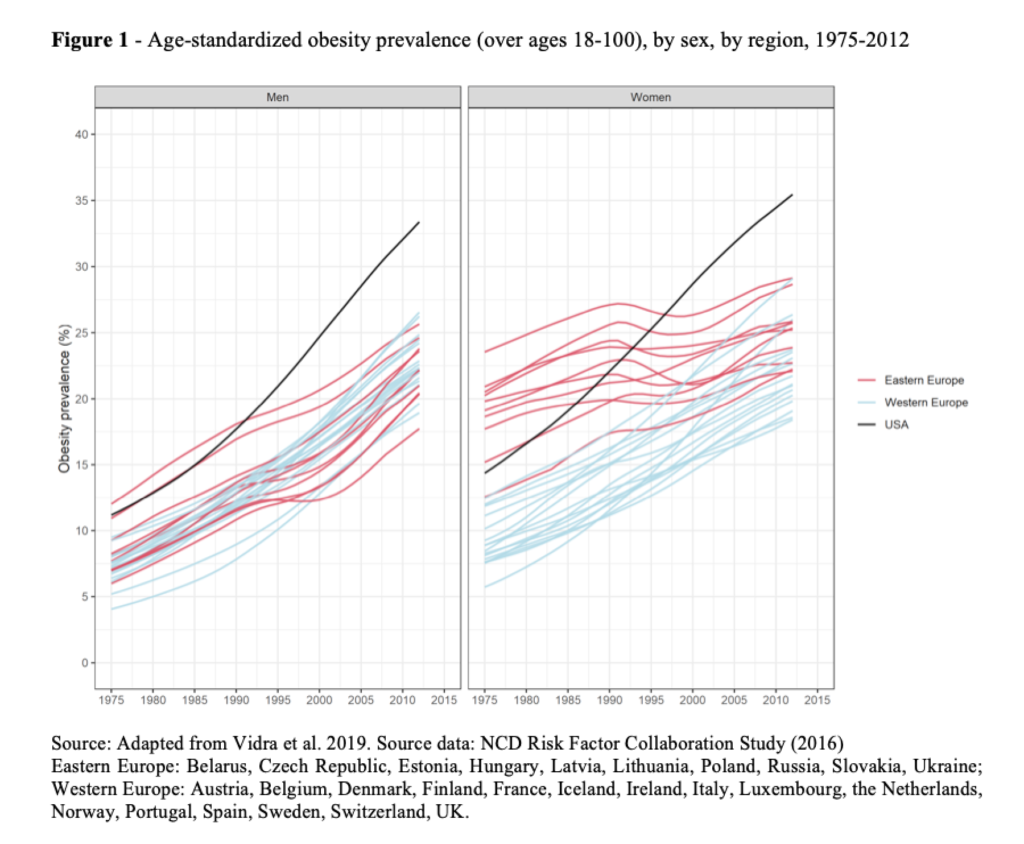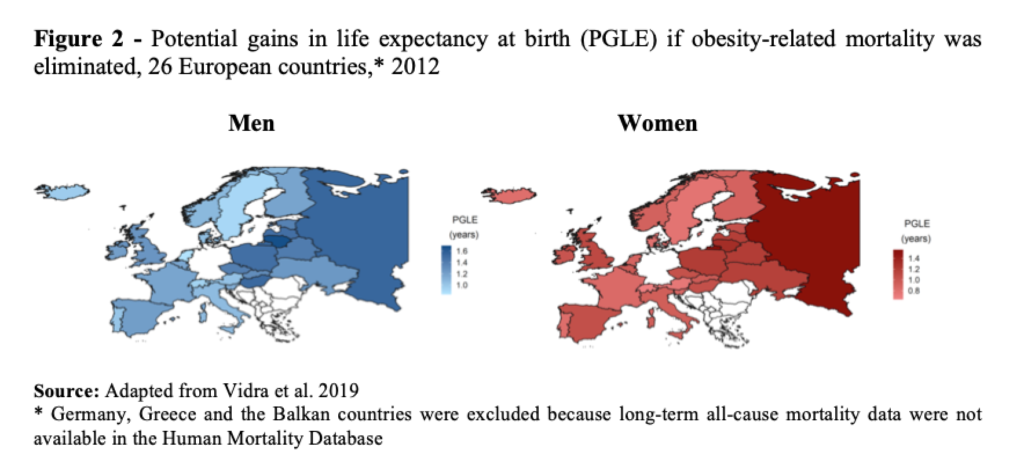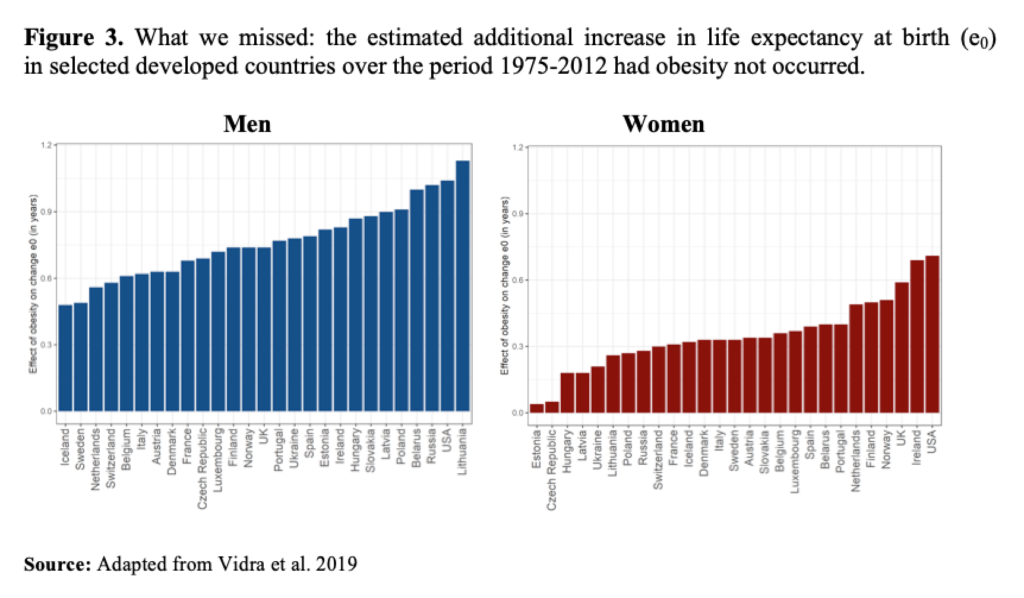Since the 1980s, obesity prevalence has increased threefold in many European countries. Without obesity, life expectancy in 26 European countries in 2012 would have been, on average, 1.2 years higher for males and one year higher for females.
Moreover, as Fanny Janssen, Nikoletta Vidra, and Sergi Trias-Llimós note, the average increase in life expectancy between 1975 and 2012 would have been 0.8 years higher for men and 0.3 years higher for women.
Obesity, defined as a body mass index (BMI) of 30 kg/m2 and over, is considered one of the biggest public health challenges of the 21st century (WHO 2018). Compared to their non-obese counterparts, obese individuals are at higher risk of developing and dying from a range of diseases, including type II diabetes, several types of cancer (breast, pancreatic, colon, rectum) and cardiovascular disease. Obesity has been increasing worldwide since the 1980s and is considered a global epidemic.
After the USA, Europe has been hit hard by the obesity epidemic, and since the 1980s obesity prevalence has increased threefold in many European countries (WHO 2018), to about 16% in 2014 across the EU member states (Eurostat 2016). However, obesity prevalence levels and trends vary substantially by gender and between European countries. Figure 1 illustrates this, using data from the NCD Risk Factor Collaboration Study (2016).
These trends are worrying, and raise the question of how obesity is affecting life expectancy levels and trends in Europe as a whole, and in different European countries.

Impact of obesity on life expectancy levels in Europe
The impact of obesity on life expectancy levels in Europe is by no means negligible. In the 26 European countries studied by Vidra et al. (2019), the potential gain in life expectancy at birth (PGLE) in 2012 if obesity was eliminated ranged from 0.86 years (the Netherlands) to 1.67 years (Lithuania) for males, and from 0.66 (Switzerland) to 1.54 (Russia) years for females (Figure 2). In the USA, the impact was very large for men (PGLE of 1.73 years) and only slightly less so for women (1.44 years).

The average PGLE estimate across the 26 European countries was 1.22 years for men and 0.98 years for women. Broken down by region, the respective values were 1.08 and 0.86 years in Western Europe, with the largest impact in the UK (1.3 years for men; 1.1 years for women), and 1.44 and 1.16 years in Eastern Europe, where the impact was smallest in Slovakia, particularly for women (1.14 years on average).
Impact of obesity on life expectancy trends in Europe
In all 26 European countries, obesity prevalence and the share of all-cause mortality due to obesity (obesity-related mortality) have risen over time. Their adverse impact on life expectancy levels and trends across Europe is increasing as a consequence.
Figure 3 illustrates the effect of obesity on life expectancy in the 26 European countries over the 1975-2012 period. On average, life expectancy at birth (e0) increased by 7.3 years for men and by 6.3 years for women. Without obesity, the average increase in e0 would have been 0.8 years higher for men and 0.3 years higher for women.
For men, the impact of obesity on life expectancy trends was greatest in Lithuania (1.1 years) – even larger than in the USA (1.0 years) – and smallest in Iceland and Sweden (0.5 years). For women, the impact was greatest in Ireland (0.7 years) – as in the USA – and smallest in Estonia and the Czech Republic (less than 0.1 year).

Explanation
We observed that the impact of obesity on life expectancy is considerable. It is larger for men than for women, and differs across Europe. For men, its impact on both life expectancy levels and trends is largest in Eastern Europe. Among women its impact on levels is largest in Eastern Europe, but its impact on trends is smallest in that region.
These country and sex differences reflect differences in the onset and the progression of the obesity epidemic. In Eastern Europe, obesity prevalence levels were already higher than in Western European countries in the 1970s and early 1980s (see Figure 1). This pattern has been linked to the relatively high total supply and intake of calories in Eastern Europe in those years (Silventoinen et al. 2004). Although these trends have stagnated, particularly among women (see below), Eastern Europe still has the highest obesity prevalence levels in Europe (Malik et al. 2013), particularly for women (see Figure 1).
The smaller mortality impact of obesity for women than men in 2012 is likely driven by different factors in Europe. Western European women, particularly those with high socioeconomic status (SES), are particularly likely to be health conscious, have healthy eating habits, follow nutritional recommendations (Fagerli and Wandel 1999), and perhaps also feel social pressure; they are less frequently obese than men. The reverse is true in most of the Eastern European countries included in our research, where obesity is slightly more prevalent among women (see Figure 1). Yet, for reasons that remain unclear, its mortality consequences are more severe for men.
The smaller impact of obesity on female life expectancy trends in Eastern Europe can be explained by the stabilization of obesity prevalence over the 1980-2008 period, especially in the 1990s (see Figure 1). This may be linked to poorer nutrition and decreased calorie intake resulting from the dramatic economic and political changes that affected these countries over the period (Silventoinen et al. 2004). For women with low SES especially, it may be related to their greater exposure to food scarcity and their higher energy expenditure (Monteiro et al. 2004).
Among the Western European countries studied, the UK and Ireland seem to be the forerunners in the obesity epidemic, and to closely follow obesity trends in the USA (Vidra et al. 2019). These countries share cultural characteristics related to dietary and exercise choices, such as widespread fast food consumption, an increasing prevalence of sedentary and inactive lifestyles, and extensive stigmatization of obese people (Donahue et al. 2018) which aggravates the health effects of obesity and hampers behavioural change.
Conclusion
Obesity clearly has an adverse effect on life expectancy levels and trends in Europe. The observed gender differences and cross-country disparities in the impact of obesity can be linked to contextual factors (economic conditions, diet, obesogenic environment), and to differences in people’s ability and capacity to adopt healthier lifestyles.
The rise in obesity prevalence will likely continue to slow down the increase in life expectancy, at least in the near future. Effective health interventions are needed to tackle the obesity epidemic and its increasing effects on public health.
Funding
This work is financed by the Netherlands Organisation for Scientific Research (NWO) as part of the research programme Smoking, alcohol, and obesity, ingredients for improved and robust mortality projections, grant no. 452-13-001.
References
Donahue, J. (2018). Obesity in the US and UK. Journal of Nutrition & Food Sciences 8(4): 1-5.
Eurostat (2016). European health interview survey – almost 1 adult in 6 in the EU is considered obese – share of obesity increases with age and decreases with education level. Eurostat News Release.
Fagerli, R. A. and Wandel, M. (1999). Gender differences in opinions and practices with regard to a “healthy diet”. Appetite 32(2): 171-190.
Malik, V. S., Willett, W. C. and Hu, F. B. (2013). Global obesity: Trends, risk factors and policy implications. Nature Reviews Endocrinology 9(1): 13-27.
Monteiro, C. A., Conde, W. L., Lu, B. and Popkin, B. M. (2004). Obesity and inequities in health in the developing world. International Journal of Obesity 28(9): 1181-1186.
NCD Risk Factor Collaboration (2016). Trends in adult body-mass index in 200 countries from 1975 to 2014: A pooled analysis of 1698 population-based measurement studies with 19.2 million participants. The Lancet 387(10026), 1377-1396.
Silventoinen, K., Sans, S., Tolonen, H., Monterde, D., Kuulasmaa, K., Kesteloot, H., et al (2004). Trends in obesity and energy supply in the WHO MONICA project. International Journal of Obesity 28(5): 710-718.
Vidra, N., Trias-Llimós, S. and Janssen, F. (2019). Impact of obesity on life expectancy among different European countries: secondary analysis of population-level data over the 1975-2012 period. BMJ Open 9(7): e028086.
WHO (2018). Obesity. World Health Organization: Regional Office for Europe.


